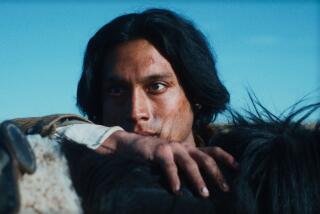‘The Tribe’ director aims for realism in depicting troubled deaf world
The Ukrainian film “The Tribe” is full of both the familiar and the unusual, as shocking for what it is as for what it is not. A film without spoken dialogue or subtitles that is also not a silent film. A teens-in-trouble movie set within a specific community rarely seen on-screen. A story that many will want to read as a political allegory, though its filmmaker says that was not the intention.
The feature debut from writer-director Myroslav Slaboshpytskiy, the film is set around a boarding school for deaf children in which adult authority is all but absent. Instead, there is a strictly structured criminal regime that runs such enterprises as petty theft and sex trafficking. As a new student, teenager Sergey (Grigoriy Fesenko) tries to navigate his way through this forbidding world and falls in love with a girl named Anya (Yana Novikova), upsetting the delicate balance of this brutal system.
“It’s not a film about deaf people, and it’s not a film especially for deaf people. It’s a film for all of us,” Slaboshpytskiy said in a recent interview. “Of course the film is for a general audience. I think people who can understand Ukrainian sign language are even disappointed.”
INDIE FOCUS: Sign up for Mark Olsen’s newsletter about film
The film is playing now at the Cinefamily in Los Angeles, with Slaboshpytskiy and Novikova appearing in person for Q&As over the weekend. “The Tribe” premiered at the 2014 Cannes Film Festival, where it picked up three prizes, and has gone on to win numerous other festival awards.
Shot in long takes that build a boiling intensity, as ambient sounds such as the rustling of clothes and the slapping of hands and bodies combine in unexpected ways, the film arrives fully formed and sui generis. In the New York Times, A.O. Scott called it “something of a formal tour de force, a triumphant overcoming of self-imposed cinematic challenges.” Grantland’s Wesley Morris wrote, “I was knocked out…. I wanted to tell the world to see this movie. I also wanted to call the police.”
In conversation, Slaboshpytskiy, 40, has a warm, genial air that seems at odds with the forceful power of his film but perhaps also reveals the source of its darkly compassionate heart.
He worked as a crime reporter before attending film school in Kiev. Having long harbored an idea to “make a modern silent film,” he began to see more and more films emulating in one way or the other the style of old silent movies. From the Oscar-winning “The Artist” to Miguel Gomes’ “Tabu” and others, those films would often be in black and white and use title cards in some way.
Among five short films he made before “The Tribe” was one titled “Deafness,” which led to many contacts in the Ukrainian deaf community. He auditioned some 300 deaf people for roles in “The Tribe.”
Making her screen debut is Novikova, a 21-year-old former college student. (Interviews with Novikova, who is deaf, often require two interpreters, one to translate spoken questions into American Sign Language, the other into Ukrainian or International Sign Language and back again.)
“The movie is about emotion, feelings, love and hate,” Novikova said via email while traveling in the U.S. in support of the film.
Slaboshpytskiy added, “It was the biggest challenge to make the story understandable without any subtitles or voice-over. This is what I was thinking about while writing the story or prepping the scenes. I think if audiences can find the story, they’ll watch it.”
The film’s production lasted six months. “They weren’t movie stars who had to be in a different city the next day,” the director said of holding on to his cast for so long. A school he attended as a boy provided the film with its main location. When the film was submitted to the Cannes Film Festival, where it premiered barely two months after shooting finished, it was with cards describing scenes that weren’t yet completed.
The film includes some intricately choreographed set pieces. Slaboshpytskiy says he is most proud of a scene in which a character is run over by a truck, simply for the logistical work involved with several stuntmen and precision planning. Yet he acknowledges the scene he is asked about most often is a harrowing abortion performed on a countertop in a dingy kitchen.
Novikova noted the scene was the toughest in the film for her.
“To go to that space required a lot of work for me. Trying to imagine the pain and confusion my character felt was difficult,” she said. “Also, it was emotionally draining, as we took the scene several times over the course of the day, which required me to cry on cue, moan in pain at a moment’s notice and so forth. It was tough.”
For all its rough-and-tumble theatrics, the film boils down to essentials of love, loyalty and survival.
“I don’t think it’s a violent film,” said Slaboshpytskiy. “As a percentage of the whole, there’s more violence in a ‘Tom and Jerry’ cartoon. It’s just our violence looks real, our violence doesn’t look attractive like in a mainstream movie. It looks like real violence in real life. Real violence is ugly.”
Slaboshpytskiy noted that one critic told him the film was like a cross between the Romanian drama “4 Months, 3 Weeks and 2 Days” and “The Sopranos.” Even given the timing of its production, Slaboshpytskiy is, nevertheless, reluctant to declare the film any kind of allegory for the recent political unrest in his homeland. He lives in Kiev and not far from Maidan Square, scene of massive protests during production.
“Maybe something was just in the air and I felt it, that something must be happening, a special atmosphere,” he said. “Of course I wasn’t thinking about that, I just tried to make a realistic film.”
Follow me on Twitter at @IndieFocus and subscribe to my Indie Focus film newsletter
More to Read
Only good movies
Get the Indie Focus newsletter, Mark Olsen's weekly guide to the world of cinema.
You may occasionally receive promotional content from the Los Angeles Times.







